

Drugs and Lactation Database. Clinical Development of Biologics Approved by the US Food and Drug Administration, 2003-2016 - G. Caleb Alexander, Ken Ogasawara, Dana Wiegand, Dora Lin, Christopher D. Breder, 2019. Nonclinical Immunotoxicity Testing in the Pharmaceutical World: The Past, Present, and Future. An examination for potential direct or indirect adverse effects on the immune system (immunotoxicity) is an established component of nonclinical testing to support safe use of new drugs.
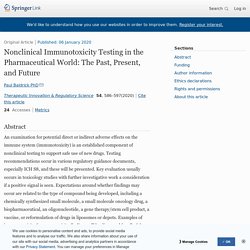
Testing recommendations occur in various regulatory guidance documents, especially ICH S8, and these will be presented. Key evaluation usually occurs in toxicology studies with further investigative work a consideration if a positive signal is seen. Expectations around whether findings may occur are related to the type of compound being developed, including a chemically synthesized small molecule, a small molecule oncology drug, a biopharmaceutical, an oligonucleotide, a gene therapy/stem cell product, a vaccine, or reformulation of drugs in liposomes or depots. Modafinil · Gwern.net. Is a wakefulness stimulant drug developed in the 1980s.
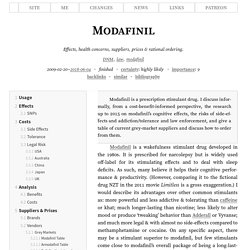
It is prescribed for narcolepsy but is widely used off-label for its stimulating effects and to deal with sleep deficits. As such, many believe it helps their cognitive performance & productivity. (However, comparing it to the fictional drug NZT in the 2011 movie Limitless is a gross exaggeration.) I would describe its advantages over other common stimulants as: more powerful and less addictive & tolerating than caffeine or khat; much longer-lasting than nicotine; less likely to alter mood or produce ‘tweaking’ behavior than Adderall or Vyvanse; and much more legal & with almost no side-effects compared to methamphetamine or cocaine.
A novel phytocannabinoid isolated from Cannabis sativa L. with an in vivo cannabimimetic activity higher than Î 9 -tetrahydrocannabinol: Î 9 -Tetrahydrocannabiphorol. Plant material FM2 cannabis variety is obtained from the strain CIN-RO produced by the Council for Agricultural Research and Economics (CREA) in Rovigo (Italy) and provided to the Military Chemical Pharmaceutical Institute (MCPI, Firenze, Italy) for breeding.
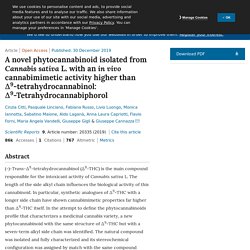
FM2 inflorescence (batch n. 6A32/1) was supplied by the MCPI with the authorization of the Italian Ministry of Health (prot. n. SP/062). The raw plant material (10 g) was finely grinded and divided into two batches: one batch (500 mg) was extracted with 50 mL of ethanol 96% according to the procedure indicated by the monograph of Cannabis Flos of the German Pharmacopoeia56 and was analyzed by UHPLC-HESI-Orbitrap after proper dilution with acetonitrile (×100). Scientists discovered a weed compound that may be 30 times more powerful than THC. Whether the new cannabinoid, named tetrahydrocannabiphorol, or THCP, will deliver 30 times the high of THC — or any high at all — is unclear.

Italian scientists also discovered a second previously unknown compound they named CBDP. It appears to be a cousin of CBD, the medicinal compound known for its anti-inflammatory, antioxidant and anticonvulsant activity. The discoveries were recently published in the journal Nature, Scientific Reports. The compounds were isolated and identified from the Italian medical cannabis variety known as FM2 using mass spectrometry and metabolomics, processes used to find the basic chemicals of a sample or molecule.
The authors assessed the ability of THCP to bind to human cannabinoid receptors found in the endocannabinoid system by sending the compound to a lab to be tested in a tube. Vitamin D status in chronic fatigue syndrome/myalgic encephalomyelitis: a cohort study from the UK. BMJ Open. 2017 Nov 8;7(11):e015296. doi: 10.1136/bmjopen-2016-015296.Vitamin D status in chronic fatigue syndrome/myalgic encephalomyelitis: a cohort study from the North-West of England.Earl KE1, Sakellariou GK1,2, Sinclair M1, Fenech M1,3, Croden F4, Owens DJ5, Tang J6, Miller A3, Lawton C4, Dye L4, Close GL5, Fraser WD6, McArdle A1, Beadsworth MBJ1,3.Author informationAbstractOBJECTIVE: Severe vitamin D deficiency is a recognised cause of skeletal muscle fatigue and myopathy.

The aim of this study was to examine whether chronic fatigue syndrome/myalgic encephalomyelitis (CFS/ME) is associated with altered circulating vitamin D metabolites. Vitamin D and the Immune System. Vitamin D study sheds light on immune system effects. Scientists have uncovered fresh insights into how vitamin D affects the immune system and might influence susceptibility to diseases such as multiple sclerosis.
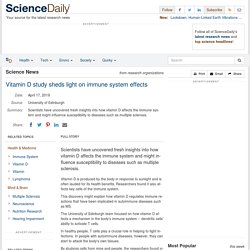
Vitamin D is produced by the body in response to sunlight and is often lauded for its health benefits. Researchers found it also affects key cells of the immune system. This discovery might explain how vitamin D regulates immune reactions that have been implicated in autoimmune diseases such as MS. The University of Edinburgh team focused on how vitamin D affects a mechanism in the body's immune system -- dendritic cells' ability to activate T cells. In healthy people, T cells play a crucial role in helping to fight infections. By studying cells from mice and people, the researchers found vitamin D caused dendritic cells to produce more of a molecule called CD31 on their surface and that this hindered the activation of T cells. Patient-Customized Oligonucleotide Therapy for a Rare Genetic Disease.
From the Divisions of Genetics and Genomics (J.K., C.H., E.A.L., A.S., J.V., R.L.D., J.C., P.B.A., A.H.B., S.E.W., O.B., T.W.Y.), Newborn Medicine (P.B.A., P.E.G.), and Neuroradiology (P.E.G.), the Departments of Neurology (C.M.E.A., D.K.U., A.
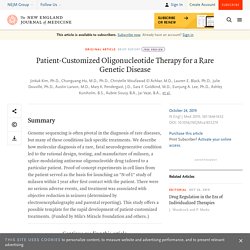
Utilizing Advanced Technologies to Augment Pharmacovigilance Systems: Challenges and Opportunities. Trends in Prescription Drug Use Among Adults in the United States From 1999-2012. Importance It is important to document patterns of prescription drug use to inform both clinical practice and research.
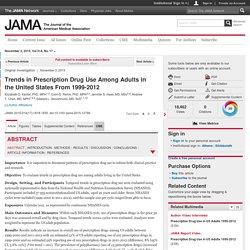
Objective To evaluate trends in prescription drug use among adults living in the United States. Design, Setting, and Participants Temporal trends in prescription drug use were evaluated using nationally representative data from the National Health and Nutrition Examination Survey (NHANES). Participants included 37 959 noninstitutionalized US adults, aged 20 years and older. Seven NHANES cycles were included (1999-2000 to 2011-2012), and the sample size per cycle ranged from 4861 to 6212. Evaluation of the impact of pharmacist polypharmacy reviews within the Govan Social and Healthcare Integration Partnership (SHIP) project. Abstract Introduction: There is a rise in multimorbidity within frail and ageing populations, which can lead to a natural increase in polypharmacy.

Local and national guidelines, such as guidance from the National Institute for Health and Care Excellence and Realistic Prescribing Scottish Polypharmacy guidance, recommend that patients at risk of inappropriate polypharmacy should be identified for review. However, owing to low levels of patient engagement in deprived areas and stringent thresholds used to define polypharmacy, a large number of patients may be excluded from pharmacy review.
Aim: The Govan Social and Healthcare Integration Partnership (SHIP) project aimed to provide multidisciplinary care to patients in one of the most deprived areas in Glasgow, Scotland, in an attempt to reduce the health inequality gap. Results and conclusions: Pharmacist medication reviews were effective, with positive feedback received from patients and members of the MDT. Pharmaceutical journal.com Reducing inappropriate polypharmacy in primary care through pharmacy led interventions. The 10 Commandments of Polypharmacy. Date April 27, 2014 Author By Eric Christianson Category Pharmacy, Polypharmacy I work with patients, nurses, doctors, pharmacists and other healthcare professionals everyday who struggle with medication management.
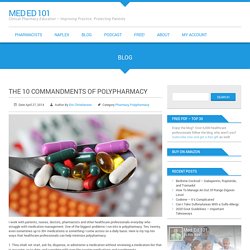
One of the biggest problems I run into is polypharmacy. Ten, twenty, even sometimes up to 30+ medications is something I come across on a daily basis. High Cost of Medication Non-Adherence. Drug therapy problems present a serious issue in healthcare in the United States. Industry estimates suggest total costs of unnecessary medical expenditures resulting from medication non-adherence to be approximately $300 billion, which represents more than 30% of the total waste (excluding fraud and abuse) in the healthcare system. Failure to take prescribed medications costs over $100 billion a year in excess hospitalizations.
It is estimated that nearly one-third of patients never fill their prescriptions, and three out of four Americans do not take their medications as directed. Medication Therapy Management (MTM) includes a broad range of activities, including but not limited to enhancing adherence through patient education, performing a comprehensive review of the patient’s drug regimen, and monitoring efficacy and safety of medication therapy, with the overall objective to enhance care outcomes and lower healthcare costs. U.S. National Library of Medicine.
Pharmacology Education Project. Invigorating. Organica. Rousing. Problematica. Vitality. Robust. Rousting. Pharmaceutical Medicine - Pharmacovigilance.